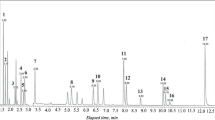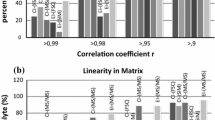Abstract
Dual detection has already been used to analyse organic contaminants in several matrices and the potential use of this technique for compound identification using the detector-response ratio (DRR) for two detectors has been reported. In this study DRR was redefined in terms of analyte concentration. The ratio was applied to compounds with both positive and negative responses fitting linear or logarithmic calibration plots. Use of DRR has been evaluated for pesticides of several chemical classes (organochlorine, organophosphorus, triazine, and thiocarbamate) and for an organophosphate ester, in aqueous matrices, using electron-capture and nitrogen–phosphorus detection. A limit of confirmation (LOC) was defined as the minimum concentration required for identification of a compound by use of the DRR. The identification results obtained were confirmed by GC–MS.


Similar content being viewed by others
References
EPA (1995) Method 508, Determination of chlorinated pesticides in drinking water by GC–ECD. In: Methods for the determination of organic compounds in drinking water—supplement III (EPA/600/R-95-131)
EPA (1995) Method 507, Determination of nitrogen and phosphorus-containing pesticides in drinking water. In: Methods for the determination of organic compounds in drinking water—supplement III (EPA/600/R-95-131)
Loconto PR, Gaind AK (1989) J Chromatogr Sci 27:569–573
Zuin VG, Yariwake JH, Bicchi C (2003) J Chromatogr A 985:159–166
Gaillard Y, Gaymontchamp JP, Ollagnier M (1993) J Chromatogr 622:197–208
Lillsunde P, Seppala T (1990) J Chromatogr 533:97–110
OhShin YS, Ko M, Shin HS (1997) J Chromatogr A 769:285–291
Tse H, Comba M, Alaee M (2004) Chemosphere 54:41–47
Bernal JL, Delnozal MJ, Atienza J, Jimenez JJ (1992) Chromatographia 33:67–76
Bicchi C, Damato A, Binello A (1996) J High Resolut Chromatogr 19:80–84
Jover E, Bayona JM (2002) J Chromatogr A 950:213–220
Pérez-Ruzafa A, Navarro S, Barba A, Marcos C, Camara MA, Salas F, Gutierrez JM (2000) Mar Pollut Bull 40:140–151
Dubey JK, Heberer T, Stan HJ (1997) J Chromatogr A 765:31–38
de Luca G, Mura M (2000) Bolletino dei Chimici Igienisti 51:99–103 (in Italian)
Rankin T, Thermo Finnigan, http://wwwthermocom/eThermo/CMA/PDFs/Articles/articlesFile_1000001009513pdf (accessed in November 2006)
Leathard DA, Shurlock BC (1970) Identification techniques in gas chromatography. Wiley, London, p 282
Oaks DM, Dimick KP, Hartmann H (1964) Anal Chem 36:1560
Bicchi C, Damato A, Orlandin M (1994) J High Resolut Chromatogr 17:335–338
Acknowledgements
This work was supported by Spanish Ministry of Science and Technology project FP-2001-0883. One of us (A. Gómez-Gutiérrez) gratefully acknowledges the Catalan Government (Generalitat de Catalunya) for a Ph.D fellowship, and E. Jover acknowledges Spanish Ministry of Science and Technology for a Ph.D. fellowship. Finally, the authors wish to thank R. Mas for her technical assistance.
Author information
Authors and Affiliations
Corresponding author
Rights and permissions
About this article
Cite this article
Jover, E., Gómez-Gutiérrez, A. & Bayona, J.M. Development and Application of the Detector-Response-Ratio Method of Identification for a Dual-Detection System. Application of GC with Electron-Capture and Nitrogen–Phosphorus Detection to the Determination of Pesticides in Aqueous Matrices. Chroma 66, 75–79 (2007). https://doi.org/10.1365/s10337-007-0270-2
Received:
Revised:
Accepted:
Published:
Issue Date:
DOI: https://doi.org/10.1365/s10337-007-0270-2




